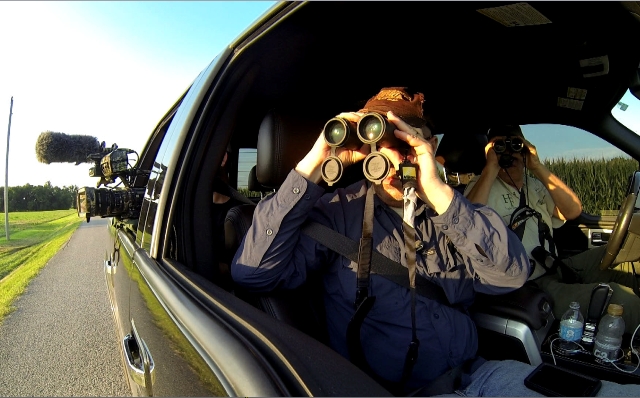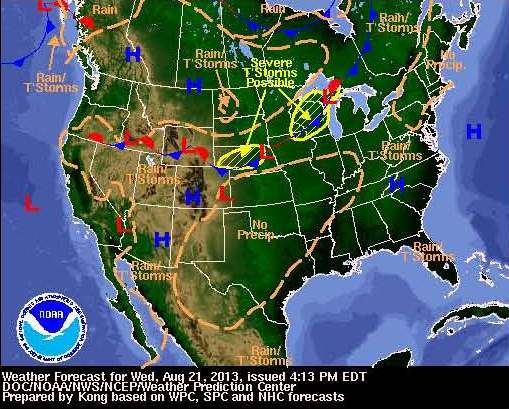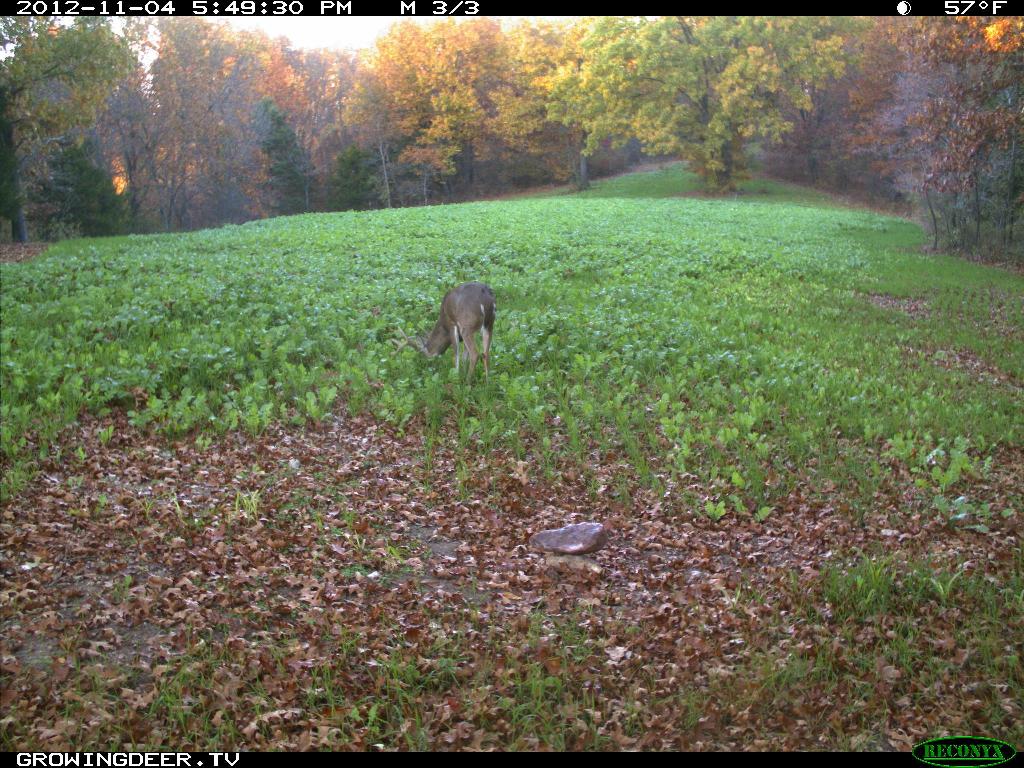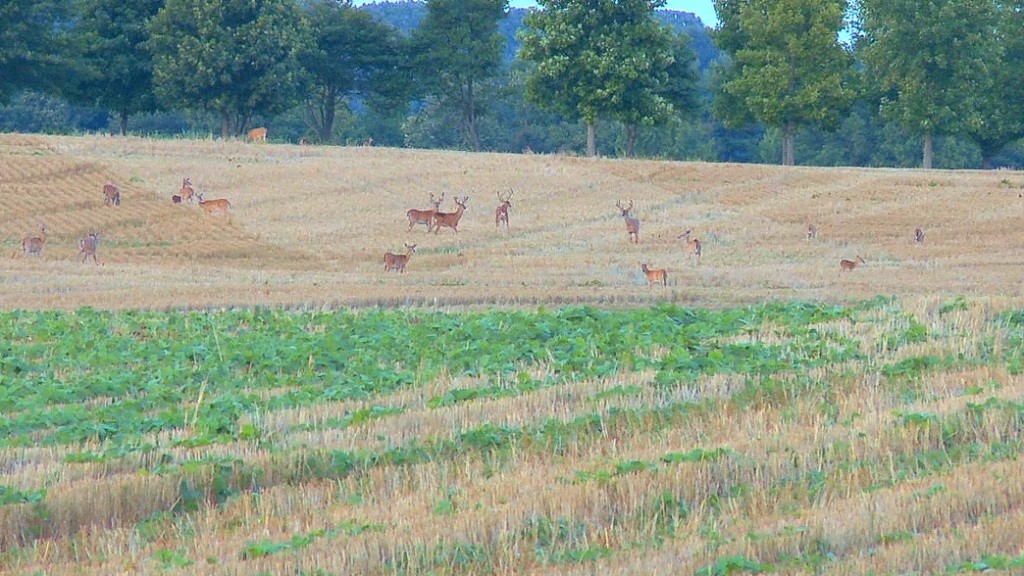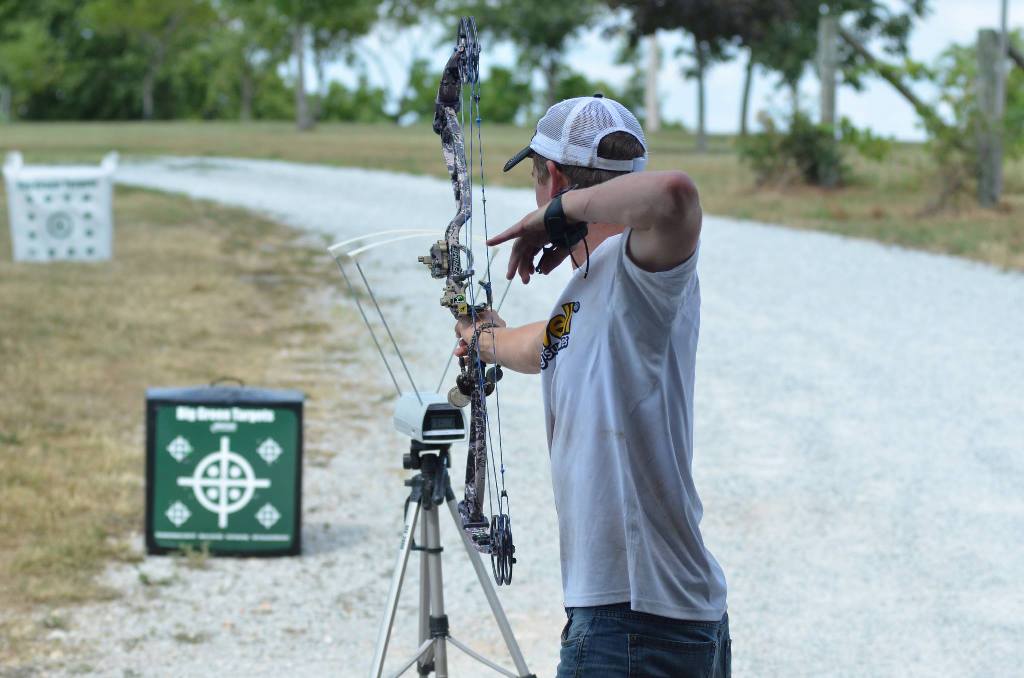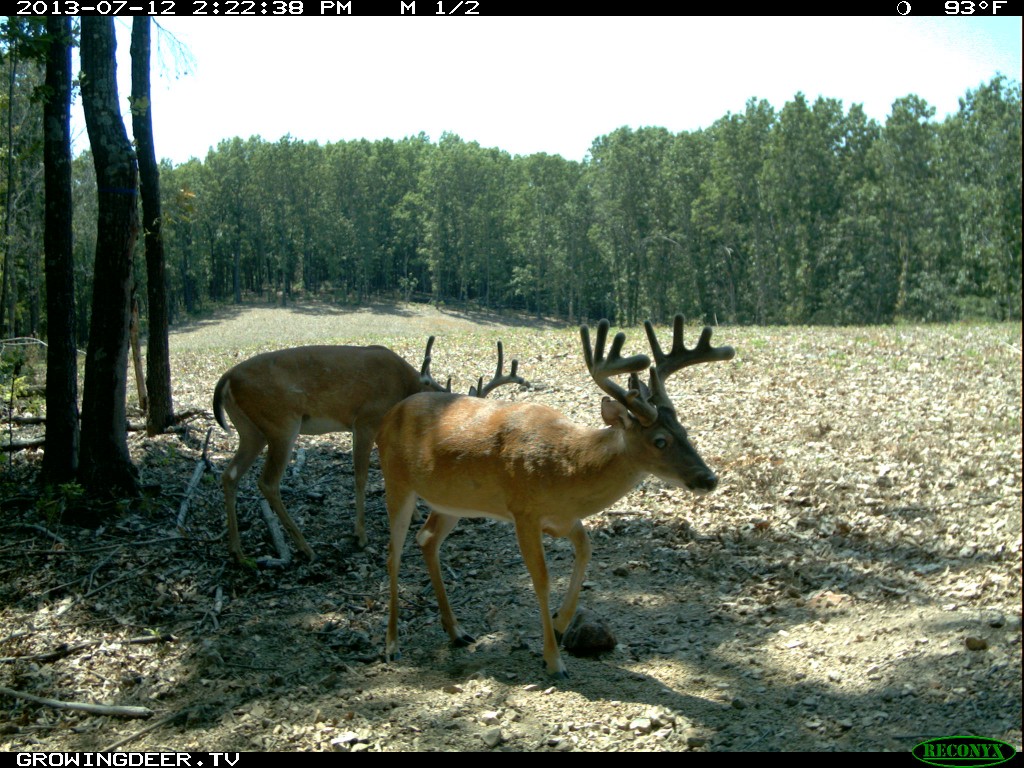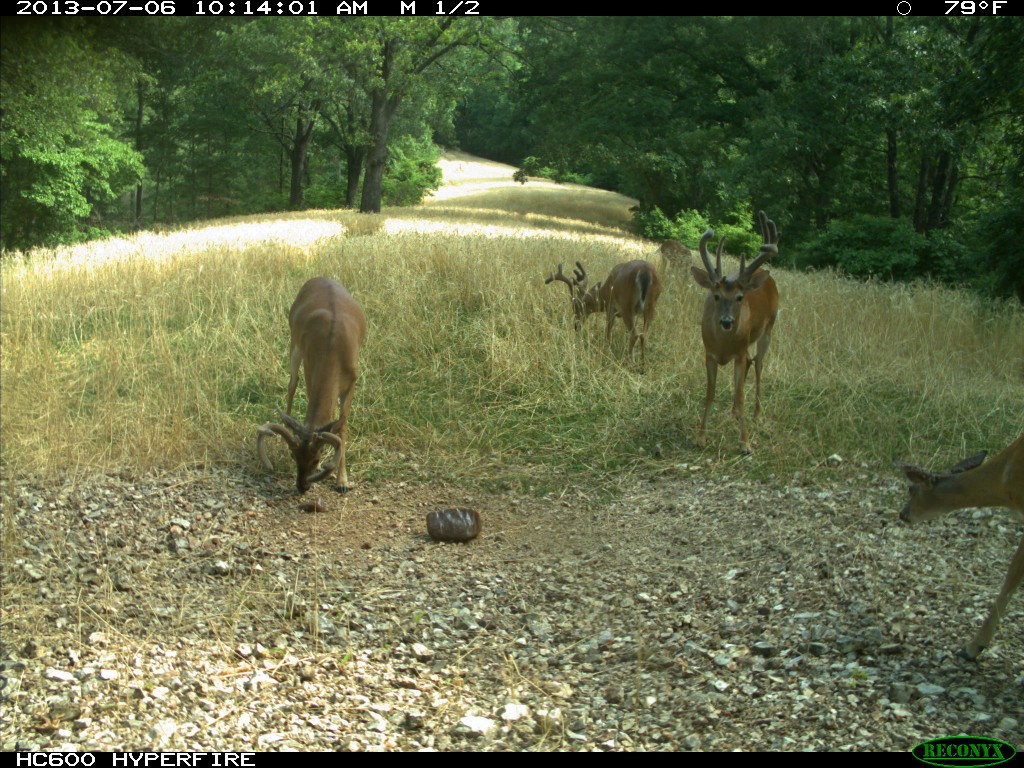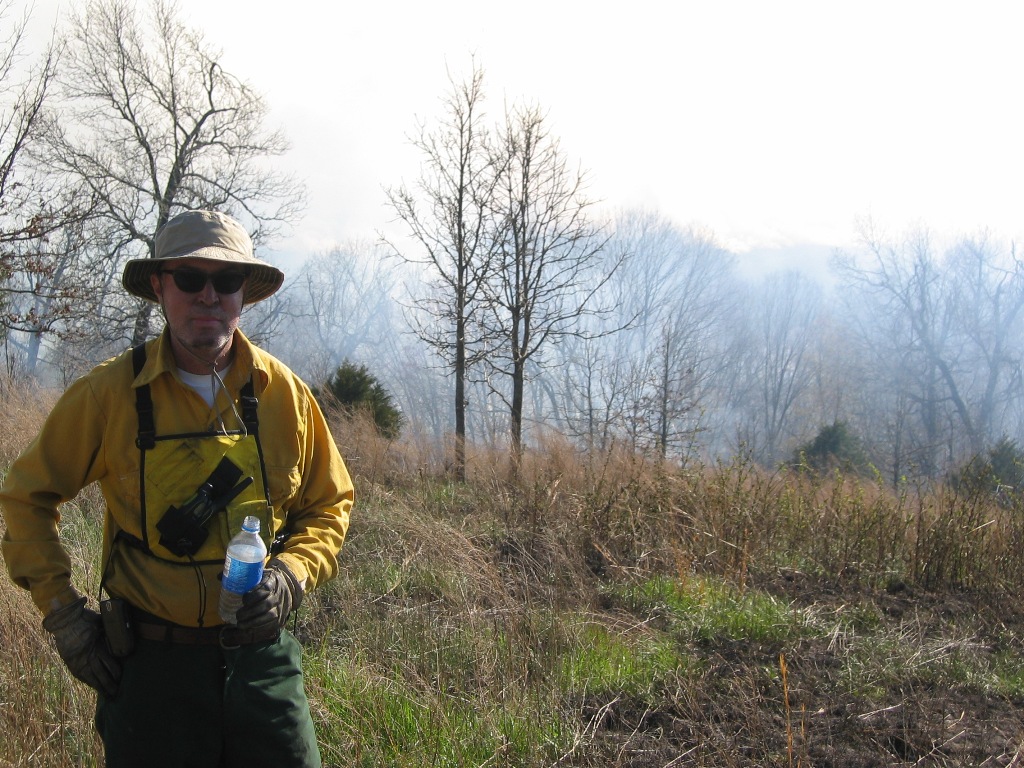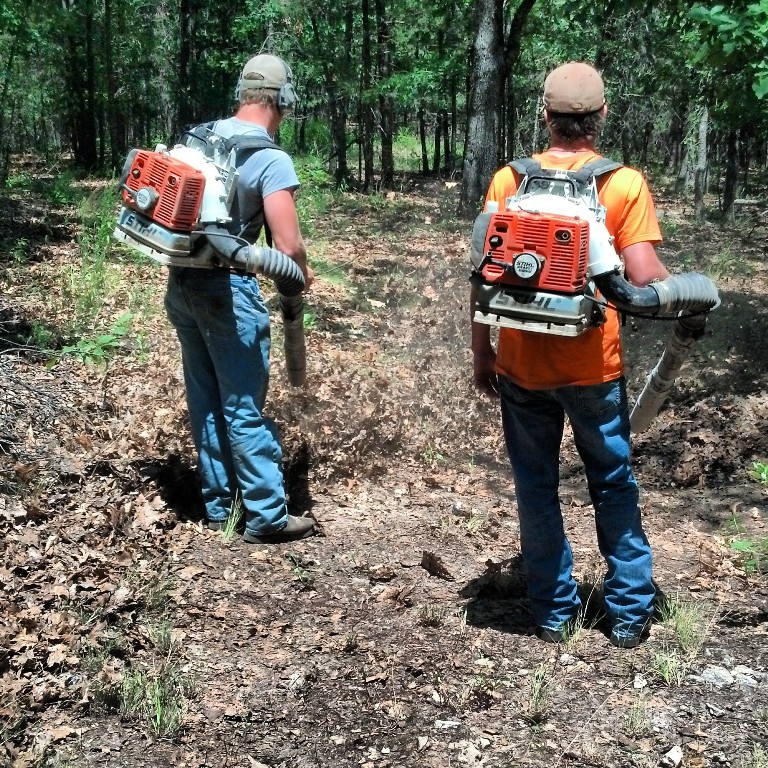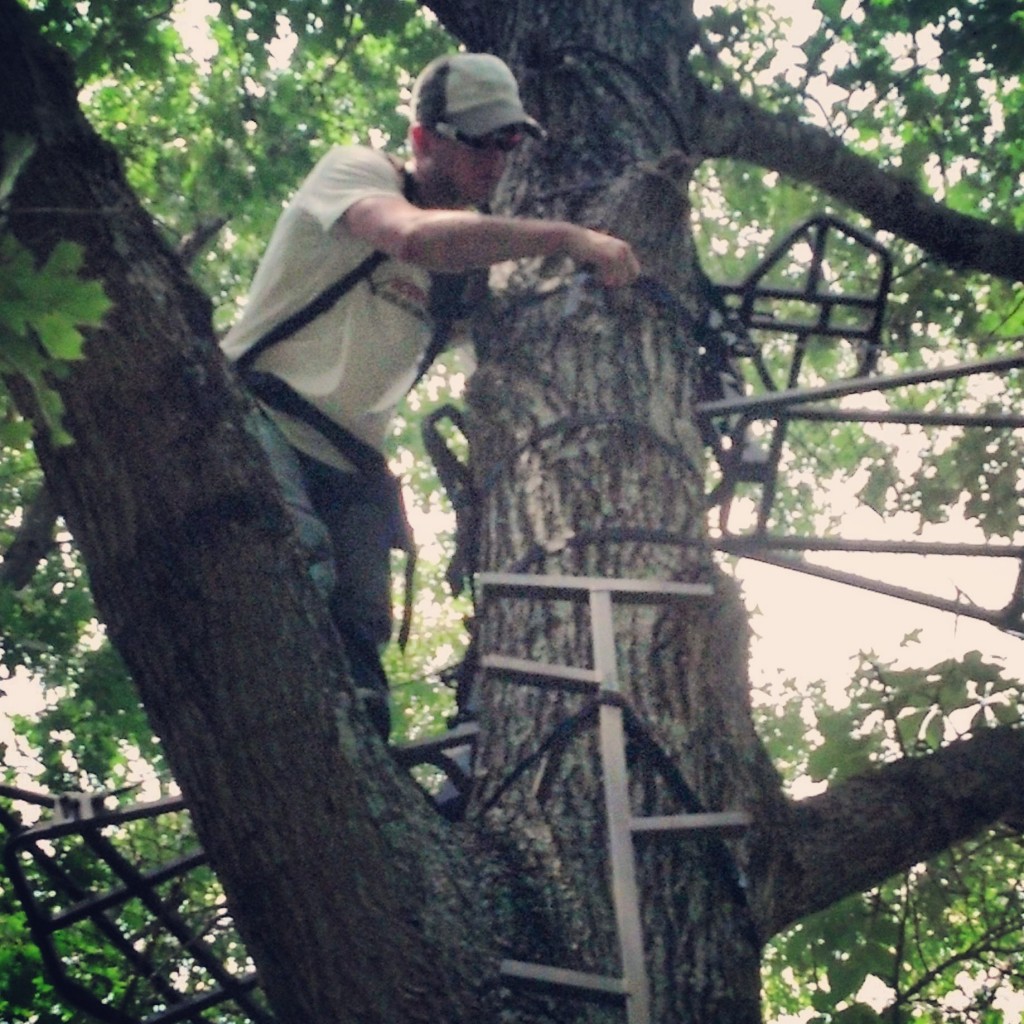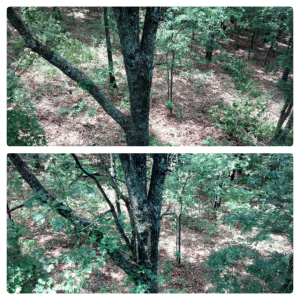Category: Hunting Blog
Scouting For Early Season Hunts!
Many hunters, including myself, are “scouting” for stand locations this time of year! However, we don’t and shouldn’t always have to spend days busting through the woods to find stand locations.
If the goal is to find and harvest a mature buck then the least disturbance we can cause while scouting and still obtain useful information is better. Mature deer have some level of memory. That can serve hunters well if deer use their memory to return to the same food source, bedding area, or water source.
However, a deer’s memory can also limit the success of hunters if deer avoid areas due to associating (remembering) that area with fear. So, I prefer scouting using Minimal Disturbance Entry (MDE).
In areas where soybeans and other crops that deer prefer are grown, scouting may be as simple as cruising the roads around the area where you hunt. Often mature bucks can be seen foraging in soybean fields just before dark. Watching bucks this way is fun, but is only the first step in this scouting technique.
Once bucks are located and you’ve confirmed that they are returning to the same field it’s time to use the best scouting tool – your brain!! Rather than go into that area and risk putting the bucks on high alert, consider where the closest bedding area is. Is there a bottleneck such as a narrow strip of woods, pinch point between cover and a river, fence gap, etc., between where the bucks are feeding and where you believe they are bedding?
If so, then consider if you can approach that area to hunt without alerting the bucks to your presence. If there is then you’ve found a great stand location! Remember that bucks often change patterns and use other parts of their home range during the next few weeks as the soybean forage begins turning yellow and the bucks’ hormones change. Once you’ve located a buck this time of year, careful scouting and stand placement can lead to filling a buck tag within the first few days of the season!
Just before and soon after bucks shed velvet they are usually on a food/cover pattern. Locating the preferred food and cover – and just as importantly, a stand location in between that allows the hunter to approach, hunt, and exit without alerting deer — is a great scouting technique!
Growing and hunting deer together,
Grant
When Should I Plant Fall Food Plots For 2013?
This week I received LOTS of questions through Facebook, etc., about when to plant fall food plots! That’s a relatively simple answer. Most fall food plot crops do well if planted 45-60 days before the first expected frost (click here for a link to a map showing average dates for USA).
In addition there needs to be ample soil moisture for the seeds to rapidly germinate and seedlings to survive. There’s plenty of soil moisture throughout most of the eastern states now. However, throughout much of the Midwest the conditions are dry and there’s no rain in the 10 day forecast.
I live in southwestern Missouri. The average date of the first frost here is October 15th. That’s about 55 days from now. However, there is very limited soil moisture now and no rain in the forecast during the next 10 days. If I planted now, another source of stress on the seeds (or seedlings if they germinated) is that the daytime temperatures are forecast to be hot! Planting now would certainly be a gamble.
If the seeds did germinate, it might not rain soon and the very young and fragile seedlings might die or at minimum be severely stressed. The Broadside blend from Eagle Seed I plan to plant is in my carport. The plots we plan to plant have already been sprayed. We are literally ready to plant but it will be best to wait for a strong chance of rain. Remember that plants, especially young forage crops, need ample moisture to survive and thrive!
Healthy forage crops not only produce more tonnage but usually are more attractive to deer than plants that are stressed from drought, etc. For best results schedule the planting of fall food plots based on timing (45-60 days before the average first frost) and ample soil moisture being available.
Growing and hunting deer together,
Grant
How to Get Closer To A Mature Buck With Food Plot Design
Last week I shared why I prefer soybeans for food plots. I also plant food plots during the fall I call Hidey Holes. These are small (often a ¼ acre or less) plots usually tucked in the woods where there’s never been a food plot or recent hunting pressure. I plant these plots to attract mature bucks.
I frequently share with hunters that the largest motivation for a mature buck is not food, cover, water, or even a receptive doe. The strongest motivation for a mature buck is fear. Let a mature buck smell or spot you while he’s chasing a doe and he’ll usually forget about the doe and put some distance between the threat and him!
Hidey Hole plots combine the attractiveness of quality forage and an area bucks don’t associate with danger. I simply find an opening in cover where there hasn’t been any hunting pressure recently and ensure the location receives at least ½ day of sunlight. I remove any duff (leaves, debris) from the soil and add plenty of fertilizer and seed. Since I’m broadcasting seed I like to plant just before or during a rain. Rain helps the seed have seed to soil contact by splashing dirt on the seed and ensures there is ample soil moisture for germination. The wet and warm seeds will rapidly germinate thus reducing the amount of seed lost to birds, squirrels, etc.
I prefer to plant a blend of soybeans, radishes, forage wheat, and bulb and non bulb producing turnips. Deer will be attracted to the soybeans first. They will likely have all the soybeans consumed before it frosts. Bucks usually go after the radishes next. Unlike turnips, deer usually readily consume the radishes before it frosts. About the time of the rut deer tend to favor the forage wheat. By this time the wheat has produced enough tonnage that it is rarely damaged by over browsing. Once the weather turns cold bucks seem to prefer the forage turnips – the ones that don’t produce a bulb. And during the late season bucks are attracted to the bulb producing turnips – both their forage and bulbs.
I’ve been tweaking this blend for years and finally have it balanced to provide attractive forage throughout deer season! Eagle Seed now offers this blend. I usually use 3 bags of 13 13 13 fertilizer since I rarely can add lime to the remote Hidey Hole plots. So with one bag of seed, some fertilizer, and a hand rake or other hand tool, I can have a Hidey Hole food plot! This has proven to be an effective tool to attract and harvest mature bucks! Next week I’ll share how I hunt Hidey Hole plots.
Growing Deer together!
Grant
Bucks in Beans: Quality Bucks At Home!
I live and do most of my hunting near Branson, Missouri – about 20 miles from the Arkansas line. I live in the Ozark Mountains. Steep, rocky, and very low fertility soil. Low quality oak and fescue pasture make up the vast majority of habitat. There are no grain fields, combines, silos, etc., associated with production row crop ag and large bucks for many miles.
My favorite food plot crop here is soybeans! Clearly there’s a close association with soybeans and bucks producing larger antlers and does producing more fawns. Yearling, two, three, and older bucks tend to produce substantially larger antlers when they consume soybean forage during the summer and pods during the winter compared to only consuming native browse during the summer and acorns during the winter.
Larger antlers (per age class) are a great indication of herd health. I like healthy deer and the by-product of larger antlers! Soybeans are unquestionably one of the best food plot forages for deer.
The biggest limiting factor for soybeans is the total acreage of plots compared to the number of deer using those plots. For example, soybeans are not a good value for a ½ acre plot in an area with a lot of deer unless the plot is protected by a Hot Zone food plot protection fence. The fences are great to protect plots and allow soybeans to mature enough that deer won’t damage them by over-browsing the young plants.
I toured a farm yesterday that is in mountainous timber country! This area typically produces 110-120” mature bucks. The bucks are simply limited by nutrition. Saplings, acorns, and fescue pastures do not allow bucks to express their antler growth potential at any age class.
Over the past three years this landowner has converted some fescue pastures to food plots planted in soybeans. Yesterday we observed some great bucks! They were much better than average for that region!
I’ve seen the same thing in pine plantations in the South. I’ve commonly prescribed for clubs to plant the thinned rows in pine stands with soybeans (Watch GDTV 19) and have watched substantial increases in average antler size and the huntability of the bucks!
Soybeans are easy to grow just about anywhere and provide great nutrition for deer. Rather than wishing you could hunt deer like you watch on hunting shows filmed in the Midwest, create some soybean food plots and enjoy the same quality bucks at home!
Growing and hunting deer together,
Grant
Bow Hunting Tips: Why Every Hunter Should Want The Sharpest Broadhead
Hunting archery equipment is designed to cause massive blood loss – quickly. This results in a humane kill with minimal suffering and stress to the game and better quality meat for the hunter. However an arrow passing through the vitals of a critter doesn’t necessarily result in massive blood loss – especially external blood loss that leaves an easy trail to follow.
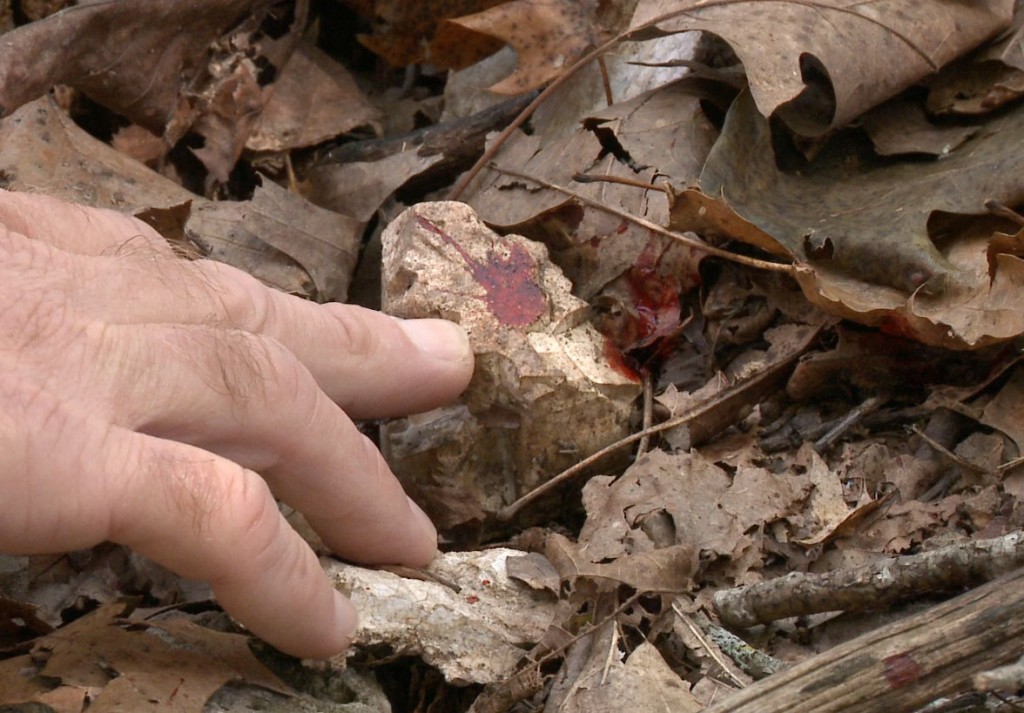
As a bow hunter I use the sharpest broadhead that flies straight from my bow and results in total penetration, a G5 Striker.
Have you ever heard of the hormone Thromboplastin? It’s known as the clotting hormone. It is released in deer (and humans) if the critter senses trauma. Wow – this is getting technical.
An easy way to understand the clotting hormone is to think back on when you had a paper cut. It’s usually tough to stop the bleeding from a paper cut. That’s because there is no or very little trauma and therefore no Thromboplastin is released.
On the other hand, when you mash your thumb with a hammer, etc., the bleeding usually stops rapidly. That’s because the body senses trauma and releases the clotting hormone.
The sharper the broadhead the less likely the critter will release the clotting hormone so the blood will flow freely without clotting. This is the primary reason I only hunt with the sharpest broadheads I can find.
My broadhead selection is based on good arrow flight (if it doesn’t hit the mark the sharpness doesn’t matter) and secondly the sharpness. I’d much rather have a smaller and very sharp cutting surface that results in less trauma than a larger cutting surface that results in a lot of trauma (which will cause the release of the clotting hormone).
I’ve tried several broadheads and have found G5’s Striker to be the sharpest. I’ve had great results with this broadhead on bucks!
Remember that bullets are designed to kill due to massive structural damage where broadheads kill as a result of blood loss. The best tool to insure rapid loss of large quantities of blood is by using the sharpest broadhead that flies straight from your bow and results in total penetration.
Just as every bow hunter spends hours practicing for the kill shot he/she should also carefully consider what’s on the business end of the arrow. My two criteria for a broadhead are that it flies straight and is extremely sharp.
Growing and hunting deer together,
Grant
Time To Get Ready For Deer Season!
We’re rolling into the end of July and the GrowingDeer Team is neck deep in preseason projects to help us prepare for the upcoming hunting season! I thought I would take some time this week to discuss those projects so you could get a better understanding of what our preparations are and what you can do to prepare for hunting season.
Most deer hunters across the US are starting to brave the heat and take to the woods to check/move and trim deer stands. Checking stands is very important! We do it this time of year because stand maintenance is crucial; plus you certainly don’t want to be trimming lanes during hunting season – ultimately alerting deer and turning them completely nocturnal. One important piece of advice on preseason stand preparations is checking your stand straps as with each year it becomes more and more important as the straps get older and spend more time in the elements. Squirrels, mice, etc. will also chew on these straps making them weaker, so always be sure to use two straps on each stand and always check them before climbing in your stand.
If you caught Grant’s blog last week you know that we’re also getting ready for our trail camera survey! This involves everything from making sure all settings on our Reconyx trail cameras are correct and the Redneck feeders are all up and ready for August 1st when the survey begins! This activity also means that I’m watching as much TV and movies as possible… now you’re wondering what the connection is? When you’re trying to come up with a unique/creative name for each buck caught on camera on a 2,200 acre ranch, you need to load your brain up with as many different names as possible…
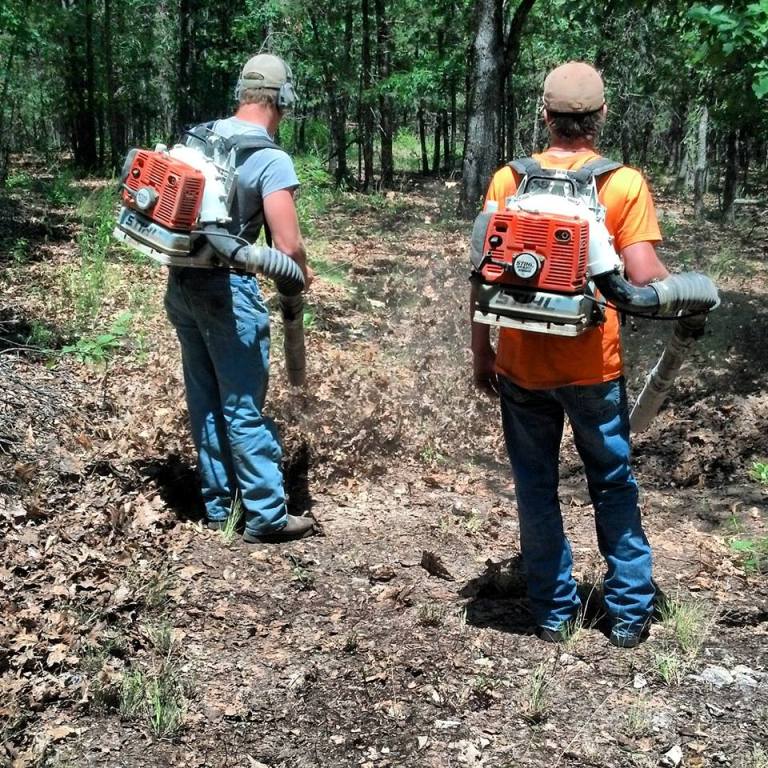
We prepare for future years of hunting with growing season fires. These fires insure quality habitat for all types of wildlife.
Even with these two main projects going on, we’re still finding time to practice our growing season fires (Watch GDTV 189)! Unlike our first two projects where we are focusing on this calendar year’s hunting season, it’s equally important to prepare for future years of hunting! One way we do this is by insuring quality habitat for all types of wildlife by practicing growing season fires. Be sure to catch upcoming episodes of GrowingDeer.tv to learn more about growing season fires.
The last two preseason projects we are doing are my favorite by far! Organizing your gear and getting it ready for opening day is very important to success! We’ll be completely washing all our camo in Dead Down Wind products, air drying them on the clothes line and storing them in our ScentMaster Locker. Although I’m not a huge fan of laundry in my everyday life, when it is camo I can feel the excitement growing! Who knew laundry could be so exciting!? We also spray down other gear, binoculars, camera arms, safety harnesses and store them. As most of the loyal fans know scent reduction is huge for us, we live, breath, and eat scent reduction! Especially at The Proving Grounds when we’re fighting thermal shifts constantly!
Lastly, and definitely my favorite step in preseason preparations: Shooting! Most serious bow hunters shoot their bows year round. As the calendar pages turn and the velvet begins to grow and antlers start forming, shooting becomes more serious. Most hunters begin feeling like a kid on Christmas Eve! This time of year I’m starting to shoot more and more, extending out to find my comfortable range. I’m doing everything I can to make sure when that time comes this fall, I’m ready to squeeze the trigger with the confidence that I’ve done all the preparation to make the shot!
It’s an exciting time of year, so get out there and have some fun getting ready for the upcoming season! As always, be safe!
Daydreaming of whitetails,
Adam
Tools For Hunting Whitetails: A Trail Camera Deer Survey
We’ve been preparing for our annual trail camera survey! A trail camera survey has been shown to be the most accurate method to determine the number or deer, the age class of bucks, and the number of fawns per doe on a specific property. Detailed instructions of how to conduct a trail camera survey can be found at this link.
Placing trail cameras and attractants like Trophy Rocks and Record Rack feeds is the easy part of conducting a trail camera survey. Plus, it’s always fun to look at all the deer pictures. Looking at each picture close enough to uniquely identify each buck can be very labor intensive. We usually end up looking at the same pictures many times to confirm the buck is the same (or different) as in other pictures.
A very accurate estimate of the total population and herd demographics can be obtained after identifying each individual buck, the number of times that buck was photographed, and the total number of does and fawns appearing in the pictures.
With the hard work completed, there’s still lots more valuable information that can be gained from all these photos! For example, I pay very close attention to which mature bucks tend to be active more during shooting light! Those bucks will usually be much easier to tag than bucks that only show up at camera sites after dark.
I also pay close attention to how the bucks, especially mature bucks, respond to each other. I look for mature bucks that are more active during daylight than other bucks and show signs of being aggressive at the camera site. Signs of aggression may be that the buck is usually the first to show up among other bucks in the bachelor group. The aggressive bucks are often photographed chasing other bucks away from the camera site.
These aggressive bucks tend to respond much better to grunt calls, rattling, and decoys. I’ll gladly spend my time hunting for an aggressive buck versus a buck that has larger antlers, but shows sign of being totally nocturnal. Such bucks may be practically unkillable – at least that year.
Currently, I’m getting a lot of images of a buck that I believe is six years old or older (based on the Reconyx trail camera images). We call him Split Brow because two years ago he had split brow tines. We’ve only had a small handful of daytime pictures of Split Brow in several years (from 1,000’s of pictures). Currently he’s showing up in front of one of my Reconyx cameras during shooting light daily! If this pattern continues, Split Brow will be at the top of my hit list due to his age and tendency to move during shooting light.
Camera surveys are a great tool for deer managers – and very useful to learn the characteristics of individual bucks! This info has served well to make me a much better hunter!
Growing and hunting deer together,
Grant
Food Plot Cover Crops For Big Bucks
We are experiencing the third consecutive growing season drought at my place. There hasn’t been a drop of rain in many weeks. Clover usually doesn’t tolerate such drought conditions very well. In fact, clover rarely is productive on rocky ridge tops that simply don’t hold much soil moisture.
If you look at the feet of the bucks in this recent picture, you will notice the clover looks good – great for being in a long, severe drought and on a rocky ridge top!
There are a couple of reasons this is the case. For years, I’ve used Antler Dirt fertilizer. Antler Dirt is composted and humified poultry litter. It’s full of great nutrients, naturally balances the soil’s pH, and adds a HUGE amount of organic matter. Regular pelletized fertilizer is acid (lime must be added to balance the pH in most cases) and has no organic matter.
Organic matter is the key to holding soil moisture! The great soils of the prairie states had a bunch of organic matter.
Second is the cover crop! Clover, especially new stands of clover, almost always benefit from a cover crop. My favorite cover crop for clover is wheat. It seems most food plot farmers consider all wheat the same. That’s absolutely not the case. Many universities perform extensive wheat variety comparisons year after year. Wheat is a very important crop in America.
Some wheat varieties produce more heads, some ripen quicker, etc. For the purpose of a cover crop, I like a wheat variety that produces a lot of forage (stays in the blade stage longer before making a stem in the spring) and stands erect even in windy/tough weather. I also want the wheat to produce a lot of grain and hold the grain so it doesn’t shatter easily.
You will note those characteristics in the wheat pictured above. Eagle Seed picked this wheat variety years ago based on several university studies. They call it Monster Wheat. I simply like it because it meets all my requirements. It does a great job of protecting the clover, continues standing even after it dries out and yields a lot of grain.
Even if the clover in this plot goes dormant due to the drought, the standing wheat grain will continue feeding the bucks and other deer and turkey using this plot – probably until the next rain and the clover starts providing quality forage again.
When planting your clover food plots, don’t forget to consider adding a good cover crop. It is a great tool that is easy to include in your food plot program – benefiting other crops plus providing quality food for wildlife during the stress season.
Growing food plots and deer together,
Grant
Why Prescribed Fire Is Good And Necessary For Wildlife
Nineteen members of the Granite Mountain Hotshot crew were killed while fighting fire this week. I am very saddened by this loss –having been a wildlife firefighter for the Bureau of Land Management while I was in college. Like all tragedies, I can’t understand the full magnitude of this event because I didn’t know any of these folks personally.
Such events make some folks question the practice of prescribed fire. These events should serve to encourage the use of prescribed fire. Fire can be dangerous. However, the lack of fire can cause much greater danger.
The Smokey the Bear campaign started after years of devastating wildfires. Those wildfires did tremendous damage and resulted in the loss of human lives and much habitat. The call to control wildfire was necessary and needed! However, the call to stop all fire and the message that all fire is bad was wrong. That campaign and the mindset it created that all woodland/grassland fires are bad have probably resulted in as much damage as the wildfires that started the Smokey the Bear program!
Researchers have studied fire scars on very old living and dead trees. The pattern is clear that most areas, especially those that were timbered (and not swamps) and grasslands were impacted by fire every three to ten years on average. The average is wide due to the average humidity, etc., at each specific area. These fires were started by lightning strikes, Native Americans, etc. It seems most of these fires were of low intensity. They may have covered 100’s of square miles, but the flame height, etc., were not like the major fires we see on TV now.
The reason the historic fires were lower in intensity was because the frequency of fire during pre-settlement days reduced the fuel loads and limited the fire’s intensity. Fires tended to burn hotter on south and west facing slopes and barely creep along on north and eastern facing slopes where the soil moisture and humidity levels were higher.
In general, since the Smokey the Bear campaign many folks have been against using prescribed fire to reduce fuel loads and improve habitat. This has proven to be a costly mistake. Fire is as natural a part of the environment as trees or grass. In fact, many native vegetation species are dependent on fire to reproduce. Others species prosper when fire occurs.
Fire results in new growth (early succession plant communities) that is extremely beneficial to many species of wildlife. Fire can reduce species of harmful insects like ticks, etc. Fire is a tool – like a dozer, herbicides, etc. Like other tools fire can be used to benefit or harm environments and people. Imagine if there had been a good prescribed fire program that had reduced the fuels in the area where those 19 hotshot crew members were killed this week. Lighting would have most likely still started a fire. But with reduced fuel loads, the fire wouldn’t have been as aggressive and intense. No one can say for certain, but those 19 firefighters might still be alive.
It’s time we changed the Smokey the Bear campaign and educated folks that aggressive, out of control fire is bad. But low intensity, prescribed fires are not only natural, but a great habitat management tool – as well as a safe and efficient way to reduce fuel loads so catastrophic fires don’t occur.
As a wildlife biologist, I use prescribed fire annually to improve and/or maintain habitat. As a forest and grassland land owner, I use prescribed fire to reduce fuel loads and ticks on my property to protect my family (Watch GDTV #89).
Researchers have clearly shown frequent, low intensity fires were common throughout the whitetail’s range. Totally excluding fire has proven to have deadly results for man and harmful results for many habitat types. Most states offer prescribed fire courses. Get educated and support well planned prescribed fire for better habitat and a safer environment.
Growing Deer together,
Grant
Warning: This blog contains information about prescribed fire which is a management tool for trained professionals using the appropriate tools for the situation.
Deer Hunting Tasks: Why Trim Shooting Lanes During June?
We’ve been hanging Muddy tree stands this week. It’s hot in Missouri here, with heat indexes over 100 degrees. We posted a picture of us while hanging stands on the GrowingDeer.tv Facebook page and someone responded “Why trim shooting lanes during June?”
That’s a good question! We primarily hunt our farm each year. We are constantly working on food plots, sanctuaries, Trophy Rock stations, trail camera surveys, shed hunting, etc. We continue learning how deer use this property during different conditions.
So we usually move some stands each year and/or trim different shooting lanes for existing stands. Hanging stands and trimming shooting lanes is hot, sweaty, noisy work. Mature bucks have some level of memory. In addition, it appears fear is their biggest motivation! It’s easy to see how mature deer could associate a stand location with fear if they experience loud noises and odors they associate with danger.
Therefore I prefer hanging stands and trimming shooting lanes as soon as the vegetation has grown most of what it will for the summer (new growth on trees is mostly complete by mid June). This means I won’t have to re-trim shooting lanes again during the fall and the area will have had months of no disturbance before hunting season.
If I wish to hang a stand during hunting season, I limit the amount of disturbance and vegetation trimmed to the minimum necessary to see and shoot. Excess disturbance during hunting season can substantially reduce the chances of harvesting a mature buck from that stand – no matter how hot the sign was that prompted you to hang at that location.
Remember, fear is probably the biggest motivation for mature bucks. Limiting disturbance near stand sites is critical to successfully harvest mature deer year after year.
Growing (and hunting) Deer together,
Grant



